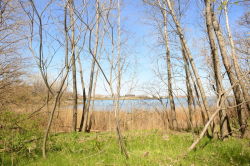Powell's Cove Park
Powell’s Cove Park
Powell’s Cove, an environmental waterfront park completed in 1999, is a bay with sizable wetlands and filled, undeveloped uplands in the College Point section of Queens. Probably named for the Powell family, who owned land in the vicinity as late as 1873, this parkland was envisaged as a waterfront park to protect tidal wetlands and the natural environment of the marshland region.
College Point, originally the Tues Neck territory of the Matinecoc tribe, was first acquired by English settlers in the 1640s. The area remained the preserve of large landowners, and in 1838 Reverend William Augustus Muhlenberg, rector of St. George Episcopal Church in Flushing, founded St. Paul’s College in the area. In the 1850s a German immigrant named Conrad Poppenhusen (1818-1883) arrived in College Point and changed the face of the neighborhood with his introduction of a rubber factory.
Poppenhusen’s factory attracted hundreds of immigrant workers for whom the industrialist created a self-contained community with schools, a library, water and sewage systems, a railroad, and a cobblestone road to Flushing. As more rubber factories followed, College Point became the rubber capital of the Northeast, until plastics replaced hard rubber in manufacturing. With the demise of rubber factories, College Point turned to other industries, but primarily became a residential neighborhood.
This park, located between 9th Avenue, 130th Street, 11th Avenue and 131st street, was acquired in two main parcels, in 1993 and 1995 respectively. The acquisition of the second parcel was a result of mitigation for the loss of parkland from the construction of the U.S. Tennis Association’s stadium in Flushing Meadows Park. Between 1995 and 1999, Council Member Michael Abel allocated over $5.5 million in funds for the creation of the preserve.
The park is divided into two parts above land, as only 7.094 acres of the park are above ground, while 17.310 acres are submerged marshlands. On the corner of 11th Avenue and 131st Street is an open-space recreation area. The field is bordered by a crushed stone path leading to two rising overlooks that stand over the cove. To the north lie the Bronx and the Whitestone Bridge. A skillfully crafted iron rod fence that depicts the landscape and skyline of the Whitestone Bridge guards the park.
Check out your park's Vital Signs
Clean & Safe
Green & Resilient
Empowered & Engaged Users
Share your feedback or learn more about how this park is part of a
Vital Park System

